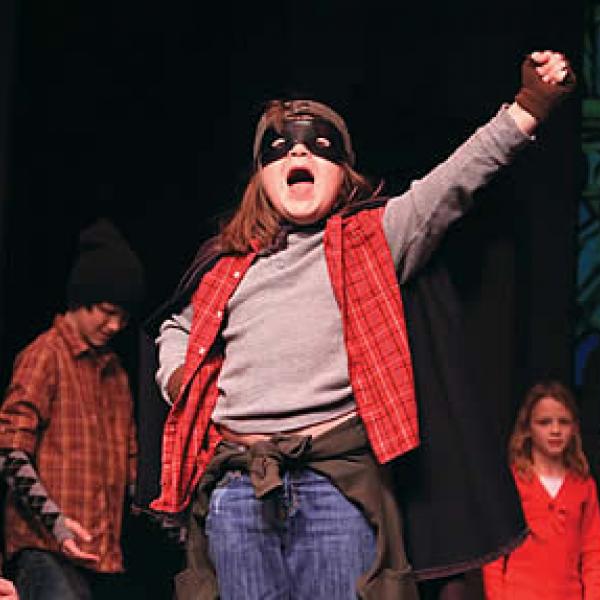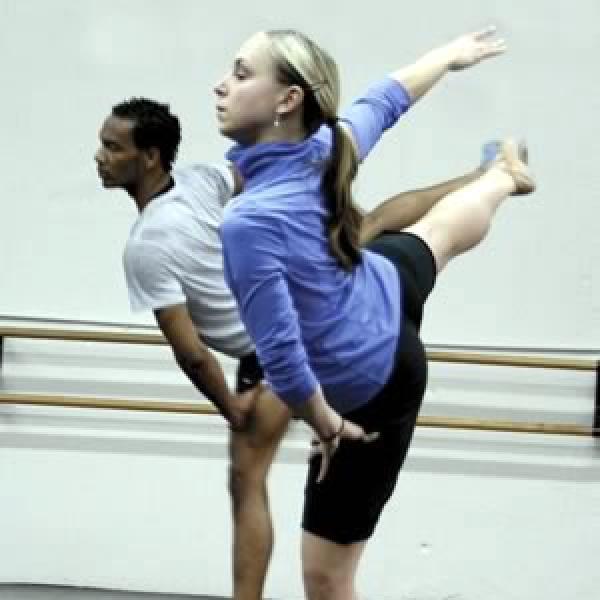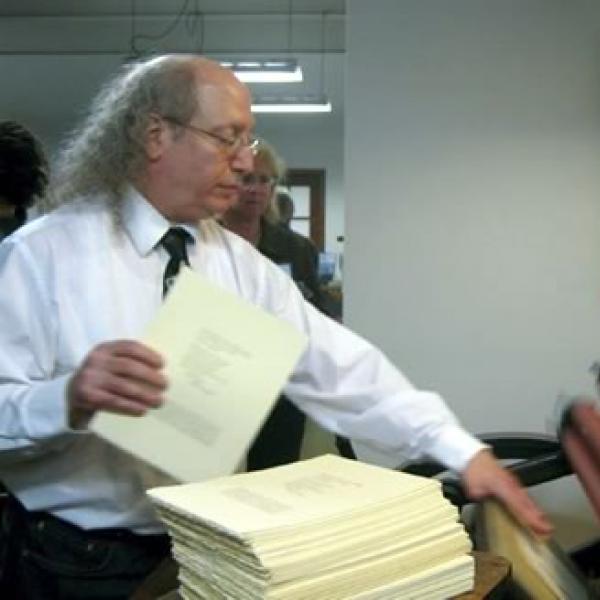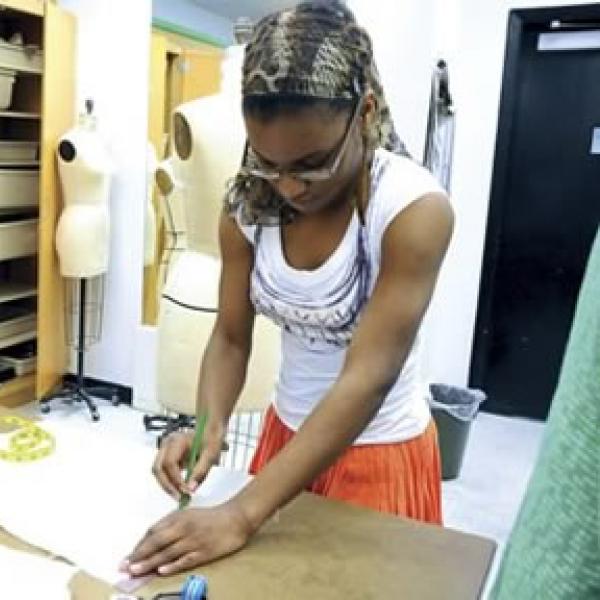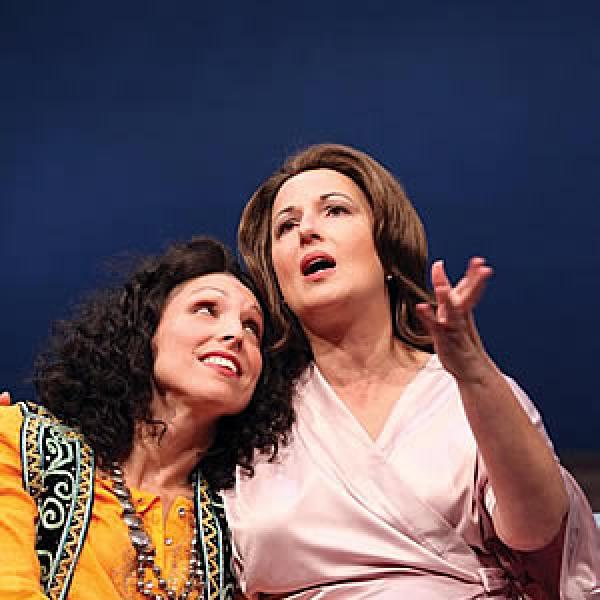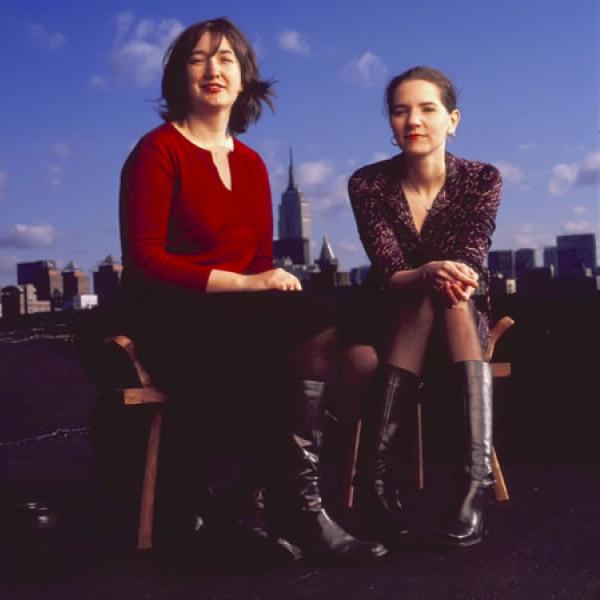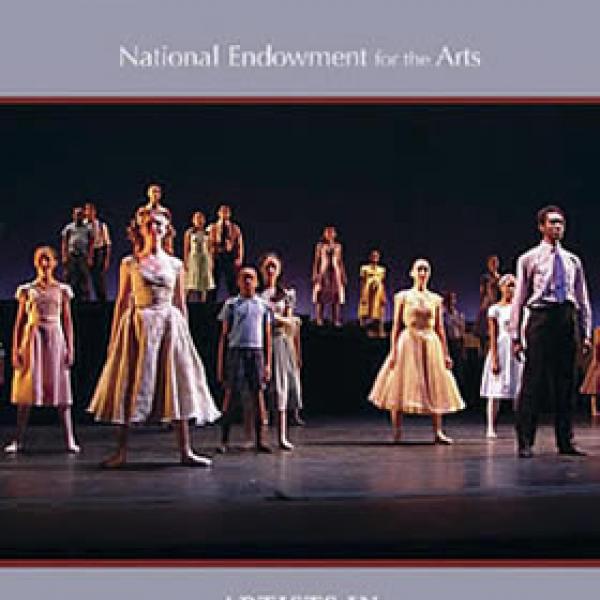Festival Theatre
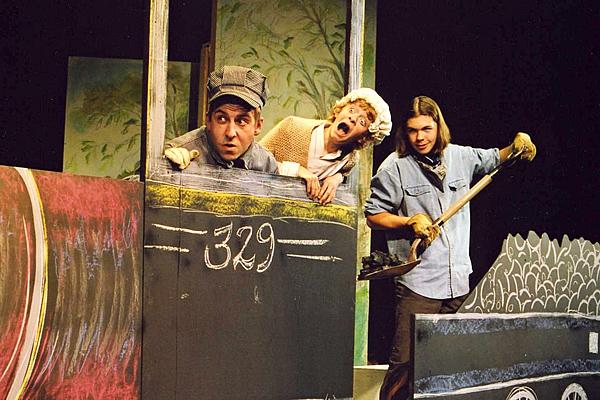
Wind in the Willows by Kenneth Grahame – a Youth & Family Theatre production directed by Bill Perron. shown are Josh Busick (guest artist) along with youth actors Jasper Herman and Hunter Teasely, Costume Design by Gina Bonin and Lisa Wondra, Scene Design by Danette Olsen & Rod Sietsema. Photo by Eileen Reich
Festival Theatre has been providing St. Croix Valley residents in Wisconsin with quality professional theater since 1990. The theater company produces seven plays a season in the rural community, which includes two children's shows. We spoke with Festival Theatre's Artistic Director Danette Olsen about the challenges and benefits of running a rural theater company.
Interview with Danette Olsen of Festival Theater in St. Croix Falls, Wisconsin
Interview by Josephine Reed of the NEA.
Q: If a small town has a theater at all, it’s usually a volunteer-based community theater. So imagine my surprise when I went to St. Croix Falls, Wisconsin, population 2,000, and discovered that the town was home to a vibrant professional theater in which actors were actually paid for their work. How does a town that size support a professional theater that seats 250 people? That was the question I put to Danette Olsen, Artistic Director of the town’s Festival Theater.
Danette Olsen: Well, to answer that question, I need to go backwards a little bit. We are in our 20th season, and the very first year that Festival Theater was born in the summer of 1990, a trio of young artists that came worked very, very hard to help the community know who they were and what their aspirations were. So they got a lot of local support at that level, and 20 to 30 percent of our audience, and the support does come from the city of St. Croix Falls and the townships right around that small city. However, they also began right away making friends with everyone in the St. Croix River Valley. Our little town is only 50 miles northeast of St. Paul, Minnesota, and so we have a very large population in the Twin Cities that we befriended and, hopefully, marketed to. We are still not as well known to that greater region as I, as I’d like. But we do our very best to attend to multiplicities of audiences. We have those folks who live in the St. Croix Falls region and in the St. Croix River Valley year-round. Then we have folks who live there part time, snowbirds who come home in the summer and are usually with us through the early fall. And we have folks who have lake homes and visit very regularly to the valley, and then another audience are those day-trippers or the motor coach tours. So we have four very distinct audiences that we market to and that we try to appeal to so that we can support professional theater in such a small town.
Q: You also have a lot of support from the town itself.
Danette Olsen: That relationship was not always as strong as it is now. In the early days, the leverage was that this 1917 vaudeville house that we call home was not occupied on the third floor where the theater space is, and quite simply, we were able to make an arrangement that we would use the space rent-free – actually a dollar a month. And but in exchange for that, we would be putting leasehold improvements into the building. We would take care of utilities and we would try to be excellent stewards of that historic building. And I think that that was great for the city, though they might not have been champions for us at that time. It took a lot of time for us to get to the place that we are now, in which the city really sees the economic impact and the cultural and social impact of our work. One of the greatest parts about that is that the local business community, most especially restaurants and lodging establishments, absolutely see the economic value of having a professional theater in the town. And so they speak up for us. Their voices ring true to the importance of having an active arts district. So we rise together, as far as all ships rising together on that economic current. There’s an interdependence that goes on in any, in a rural area. It probably doesn’t really matter so much what your business type is. If you look to your business fellows and you try to take good care of each other, looking first to spend your assets locally, so, yeah, the lumberyards being able to buy any of our goods and services locally, hiring the local piano tuner to come in. So, so we have an economic life in which we are interconnected, and there’s a great deal of interdependence. We do spend about 80 percent of our cash outlay of monies within 30 miles of St. Croix Falls, intentionally.
Q: Tell me, what are some of the challenges of running a professional theater in a rural area?
Danette Olsen: One of the greatest challenges in a rural area is simply marketing and maybe that’s exacerbated by our times and maybe we’re actually helped by our times. But for instance, almost every region has a- a series of independent local weekly newspapers. So we have to make choices, hard choices. How many of these 40 weekly newspapers in the St. Croix River Valley where we have a presence in and how much of a regular presence where we have, we’re very fortunate. We get, we submit press releases and get very good print coverage from the local newspapers. But you have very little control over that, so you have to make decisions about where to place your advertising dollars, and getting the word out to people. It happens over and over again that people, after a show has closed, like, “Oh, I didn’t even know that that show was up,” even though, maybe we’ve put up posters and put brochures everywhere and used social networking and eBlasts and our website. So that is a very, very big challenge. We have a limited marketing budget and we- we try to spread it out in a way that makes sense to us. We do a lot of asking, “Where did you hear from us?” to make those decisions. But marketing is one major challenge for us in a rural area.
Q: You’re committed to, what, seven plays a season?
Danette Olsen: Seven plays. That includes our Youth and Family Theater Series, so we do produce five main-stage, professional shows in our regular theater series, and then we also produce two children’s shows, and that is the Youth and Family Theater Project, in which we put youth actors on stage with mentors, acting mentors and directors and so that the youth in the community get a chance to have a model that will really prepare them. It’s a pretty professional model, and so children as young as six years old are getting a theater experience. And those two shows, when they’re put on stage, are treated to the exact same types of marketing and support that a main-stage show gets. So, so we do have seven shows, and then every year we also have a chance to take on special projects. So in this particular year, there will be a total of nine different productions that are on our stage. Because of The Big Read, we will have “Our Town.” And then a little later this year, in a special partnership with Family Pathways, which is a social service organization, we will be staging “Nickeled and Dimed” as well.
Q: How do you make decisions about what plays to put on? Walk me through that process.
Danette Olsen: there’s one great advantage that I have, and that’s that I grew up in this little rural area. And though I moved away, I came back to work in my field in the county that I grew up, and so I feel like I’ve got a real close connection to the people in the sense of what’s important. I really believe that if you don’t see some part of yourself on stage that maybe your experience isn’t going to be as relevant. Choosing something for our stage means that we have to have a great story. It comes back to the literature. It comes back to the story. And is this a story that’s gonna resonate with our audience? Is it going to be a story that our artists are going to be joyful in producing? Then it gets on the short list. Moving from short list to the hit list is something different, too, because then another part of the art of it starts to unfold. And that’s the- the art of putting together a season that has some connection within itself, some kind of theme. And it doesn’t have to be a heavy-handed theme. To me, it just, you know, is there a red thread? Is there something that holds the season together? And sometimes it’s very obvious and sometimes it’s not. It sounds a bit complicated. It involves a lot of reading of plays and sometimes many, many times. Sometimes, it comes down to stageability. We have a small and unusual space at Festival Theater, being a 1917 vaudeville-era theater. Lots of things that go into that, but primarily coming back to the audience, the story and the artists that have to bring it to life.
Q: Well, let me ask you, Danette. As you said, you grew up in the area. How was the theater used when you were a kid?
Danette Olsen: In that building that I now work was a single-screen movie house, which was there from 1918, shortly after the building opened, until 1985. So I spent quite a bit of time in that building seeing movies. And I am just amazed that there’s a professional theater in the county in which I grew up and that all of the kids in that area get a chance to see theater close at home and to participate in theater that’s for them.
Q: Do you get involved in arts education in the area? Do you do that?
Danette Olsen: Yes, we do. We do. When the theater went through some changes in 2005 and I came onboard in 2006, one of the things that was very important to the board of directors is that we would create and really launch an exceptional arts education program. And we wanted to do that so well that we didn’t do it right away. It wasn’t until 2008 that we got our big piece of the arts education program together. And that is the Youth and Family Theater project and I described that earlier. We also do something called Creativity Camp, which is a multi-arts day camp. And we bring that program into different communities. We court and choose host organizations and host sites that would be a great place for children to have a creative experience in a summer camp setting. And we take as many programs as we can, arts education programs into communities, into libraries to help have an impact, bringing our art to them.
Q: As you say, the festival Theater is housed in this great historic landmark. Can you talk about ways you’re continuing to develop the space itself?
Danette Olsen: That’s true. Our building also was home for twenty-some years to the local library, which is now in a lovely new home on the other end of Main Street. And the space that they occupied was at the main floor, which was originally a community center when that building was open in 1917. And so as we have imagined reuse of that space, many things will happen. It will become a place to have a little bit greater cafe service. It will be, provide us with some alternative performance area. And we think that if we properly market providing some daycare services to families, that that will help families with young children be able to come to the theater. When those plays aren’t, you know, designed or aren’t appropriate for young children, their kids can be onsite with us at the theater and having some kind of art experience on the lower level, on the street level space. So that’s one thing that we do to try to accommodate parents. But also, this lower level space is going to become home to a brand new program for us in which very young children, maybe as young as 3 years old, but the 3 to 10-year-olds have a chance to do small plays and- and little plays and get a chance to experience some theater arts making prior to moving upstairs to the main stage.
Q: That sounds like a versatile space with a lot of possibilities.
Danette Olsen: We do have some ideas perking. We will be using the street-level space, the new space, for a program that we call New Doors. New Doors is absolutely meant to be a program that encourages new talent, new ideas, new works by known talent to be work-shopped. Kind of arts incubator area. And so the space can be reconfigured many different ways. It- whatever performing arts and multi-arts experience that is being thought of by an artist can be brought to that space and have an audience. And we will help promote bringing an audience and providing feedback so that artists have a place to- to put their ideas out there. One challenge in a- in a rural area is, you know, what are your performance options? You know, it can be difficult for in artist to have a place to perform. We’ve done a few projects like that over the last couple of years, but now with this new space, I think we’re gonna be able to really green light the program and- and see some great things happen in that space for artists.
Q: Do you find that projects like these help in terms of audience retention?
Danette Olsen: It is a great way to retain audience loyalty and also to grow an audience. Theaters everywhere have a reality, and that’s that their demographic is generally folks whose kids have grown up, and so it might be, you know, the mid-40s, 50s and- and retired folks, a combination of busy lives for people in their teens, twenties, thirties, or they’re raising children. Or possibly, they just think that theater’s not for them. We believe that having some of these new and sometimes edgier programs, things that are novel, original, cutting-edge may help attract new folks. So we’ve got that combination of doing something special and interesting for the audience that already knows us, and also reaching out to audience members who haven’t found us yet.
Q: And we talked about some of the challenges of rural theater, but boy, there seem to be a lot of benefits.
Danette Olsen: Well, there are a lot of benefits. First of all, I think lots of folks in the theater, especially in urban areas, feel like they have to be a niche theater or that they have to do something really special and really unique. And they, you know, maybe build a box for themselves and somewhat maybe out of necessity. We don’t have that same necessity. In fact, we have the opposite. We need to be a little bit broader based. We need to try to do a little something for everyone and do it very, very well. We have an immediacy of feedback that’s a great benefit. Word of mouth can go like wildfire in a small town. So when a show is good, people all know about it fast. If it’s stinky, I guess they do too, but since we don’t do stinky work, it’s not a problem. So you know your audience. You know them really well. You can call them up and- and ask them for their feedback. You can get their two cents worth on the way out the door. Our theater seats 250 people, so the opportunity to have an authentic, real, rich relationship with our audience is- is huge. It’s important for the art and it’s really important for this relationship building that goes on and- and retaining that audience. There’s the benefit of being able to step out your front door at this theater and, you know, we’re right across the street from that beautiful, scenic St. Croix River. It’s a beautiful, beautiful landscape. It’s a beautiful place to- to make art and to be inspired in our art making. Artists that come to work with us-- it’s a funny thing about theater. You spend so much of your time in a dark room. So when they get their downtime they’re able to go out into a beautiful countryside. And whether they hike or ride bike or want to be on the river, they have that- again, that immediate opportunity to connect with a very inspiring and beautiful landscape.
Q: That was Danette Olsen, Artistic Director of Festival Theater in St. Croix Falls, Wisconsin. To find out more about how art works in communities across America, keep checking out the artworks blog. I’m Josephine Reed. Thanks for listening.


